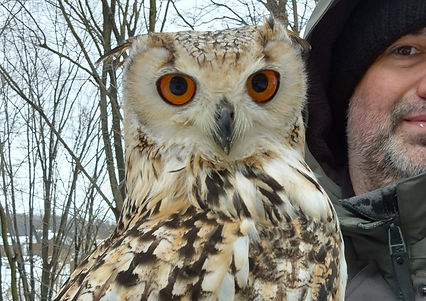Magic the Bengal Eagle Owl
Magic is a new member of the team and our second type of Eagle Owl. He is an experienced bird that was once trained and then used in a breeding programme for many years before being re-trained as a display bird for our team.
This Owl costs approximately 100zl per month to feed and care for, by sponsoring him you provide enough food for a month. 130zl covers food and vitamin supplements, 180zl covers everything we need to give him a comfortable life.



Bengal Eagle Owl (Bubo bengalensis)
Appearance
The Bengal eagle owl is also widely known as the Indian eagle owl or rock eagle owl. It is a large species native to hilly and rocky scrub forests in the Indian Subcontinent. It was earlier treated as a subspecies of the Eurasian Eagle Owl. This owl typically weighs 1000g to 2000g and therefore isn't as large as its relative the Eurasian Eagle Owl.
Food
Predominantly, they hunt small mammals, such as rodents and rabbits with their favourite meal being a rat. The Bengal Eagle Owl is an example of a farmer’s friend, consuming vast numbers of small mammals including vermin every year.
Habitat
Eagle owls are one of the most widely distributed species of owl. This variety are found living in the Bengal region of India. Owls may be killed by man as they are often thought of as bad omens in certain parts of the world. The use of pesticides in agriculture is also to blame for owl deaths.
How long do they live?
Bengal eagle owls are relatively long-lived, typically reaching 20 years in the wild and up to 50 years in captivity. So hopefully our owl will be around for you to see for most of our lifetimes.
By donating you...
Help us to educate people in more detail than above with public visits with our birds.
You are helping to protect the future of these birds in the wild as we raise awareness of ways to help their wild populations through conservation.
Please remember that Owls do not make good pets for inexperienced keepers. They require lots of studying, upkeep costs and correct housing on top of the daily care and attention to allow them a life as close to that of their wild populations as possible.
